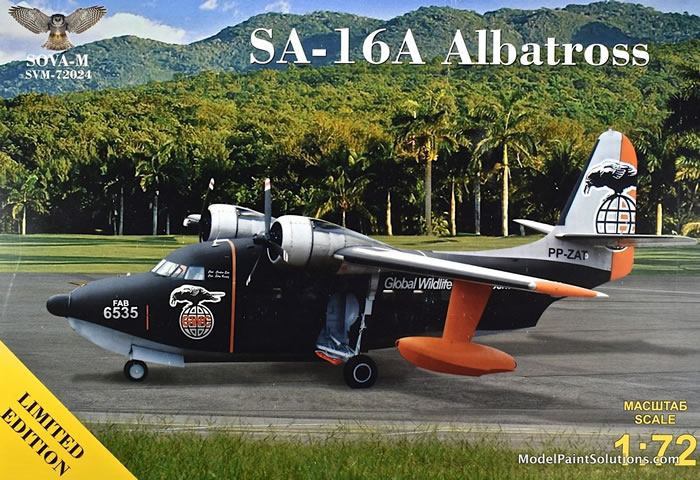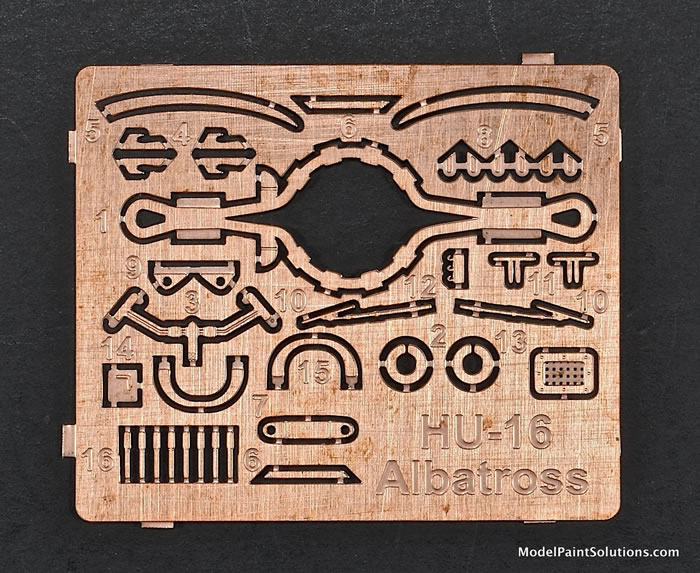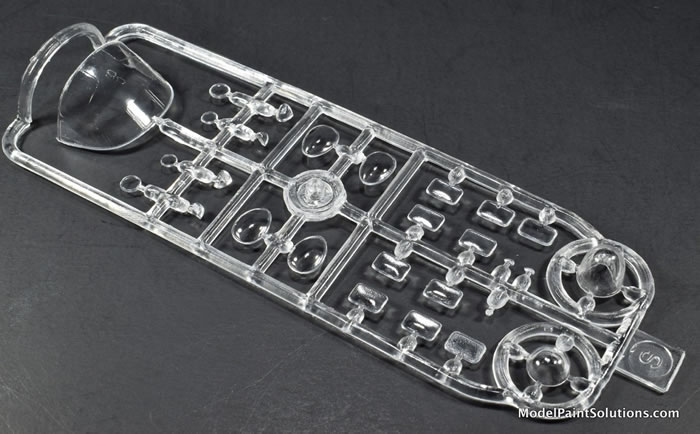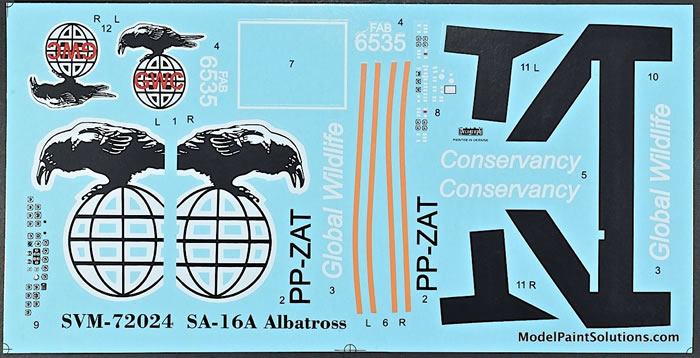SA-16A Albatros

SOVA-M, 1/72 scale
S
u m m a r y |
| Catalogue Number: |
Sova Kit No. SVM-72024 - Grumman SA-16A Albatross |
| Scale: |
1/72 |
| Contents and Media: |
214 parts in grey styrene, 25 clear parts, 16 photo-etch parts, and one decal sheet with markings for one scheme. |
| Price: |
£32.88 Plus Shipping from Hannants
and retailers wordwide. |
| Review Type: |
FirstLook |
| Advantages: |
Finally a new-mold Albatross complete with masks and PE. There are those that will be very happy, indeed. |
| Disadvantages: |
Some of the smaller parts are a bit soft requiring refreshing with a blade and files prior to use. Likewise, there’s some flash to contend with so be sure you’ve got your abrasive tools at the ready. You’ll probably want to polish out some of the clear parts as well so don’t put the abrasives away too early :). |
| Recommendation: |
This is a very neat kit that will build into a nice-looking model but it’s going to take some extra work to get all of what’s provided in the box. As with most limited-edition kits, some time will be spent removing flash and refreshing parts with files and a scriber. Similarly, I suspect the larger parts will require a lot of test fitting to achieve a good fit but the result will be a model not often seen at the model shows.
Recommended! |
Reviewed by John Miller

The Albatross was used by the U.S. Air Force (USAF), primarily in the search and rescue (SAR) mission and initially designated as the SA-16. The USAF used the SA-16 extensively in Korea for combat rescue, where it gained a reputation as a rugged and seaworthy craft. Later, the re-designated HU-16B (long-wing variant) Albatross was used by the USAF's Aerospace Rescue and Recovery Service and saw extensive combat service during the Vietnam War.

In addition, a small number of Air National Guard Air Commando Groups were equipped with HU-16s for covert infiltration and extraction of special forces from 1956 to 1971. Other examples of the HU-16 made their way into Air Force Reserve, U.S. Navy, Coastguard rescue and recovery units prior to its retirement from service.
(Edited from Wikipedia)
Right off the bat, there’s a distinct impression upon inspecting the sprues that this is not a “shake ‘n bake” kit; oh no. There’s flash to contend with and some of the smaller parts are a bit soft in execution. Additional work with a blade and small files will be needed on some parts prior to use.
That said, the surface details, both recessed and raised are scale-appropriate and nicely done overall. Some areas however are a bit soft and uneven and will require refreshing with files and a scriber prior to priming.

Assembly starts with a very detailed cockpit that includes multi-part pilot- and crew-seats, detailed yokes, and instrument panel details from a crisply printed decal. This is followed by the nicely detailed main wheel wells, which are glued onto the inner face of each fuselage halve.

Next, the large, square fuselage windows and small port hole windows (13 total) are glued into the fuselage halves. Some of the window parts have a noticeable texture that will have to be sanded out and polished prior to use.

With an appropriate amount of nose weight installed (16 grams/0.56 ounces) the assembled cockpit is captured between the fuselage halves and the builder is directed to the two multi-part engine-cowl assemblies and wing center section, composed of a single-piece, full-span upper part with right and left lower engine nacelles. This is followed by the left and right outer wing panels, each composed of upper and lower halves.
The next step in the build looks like a Red Flag Moment as the outer wing panels affix to the wing center section by a butt-join with no internal structure for alignment or, more importantly strength. I would suggest a few moments scratching a spar-like internal support for each wing will be an investment in not seeing your Albatross with drooping wings a few years after its placed in the display cabinet.
With the addition of the single-piece horizontal stabilizer/elevator, rudder, and engine cowls (with integral engines), the airframe is largely complete.
The rather complicated main gear retraction mechanism is replicated nicely with a correspondingly complicated, 7-part assembly. Similarly, the twin nose wheel is comprised of 8 parts.
With the landing gear affixed, the wingtip floats (from L and R halves) and wing fuel tanks (from upper/lower halves) are up next. The weight of both the tanks and floats on the outer wing panels is another reason to beef up the wing panel-center section join with internal structure earlier in the build sequence.
The model is finished off with the addition of a multitude of small airframe parts including handles, antennae, and balances made of both styrene and PE.
Marking Options
The decals by Decograph are crisply printed with good registration and scale-appropriate colors and densities. Markings for just one airframe are provided, Albatross PP-ZAT/FAB6535 of the Global Wildlife Conservancy, which features a distinctive black, grey, white, and orange scheme.

If you’d prefer your Albatross in a more traditional scheme, the folks at Sova-M have you covered with these additional kits:
-
#72026: SHU-16B Albatross, U.S. Navy
-
#72027: UF-2 Albatross, Japanese Marine Self Defense Force
-
#72036: SHU-16B Albatross, Spanish and Chillean Air Forces.
This is a very neat kit that will build into a nice-looking model but it’s going to take some extra work to get all of what’s provided in the box. As with most limited-edition kits, some time will be spent removing flash and refreshing parts with files and a scriber. Similarly, I suspect the larger parts will require a lot of test fitting to achieve a good fit but the result will be a model not often seen at the model shows. Recommended!
For more on this review visit Modelpaintsolutions.com.
The review kit was kindly provided by Mike “The Weatherman” Millette. Thanks again, Mike!
Review Text Copyright © 2020 by Model Paint Solutions
Page Created 20 May, 2022
Last updated
20 May, 2022
Back to HyperScale Main Page
Back to Reviews Page |
